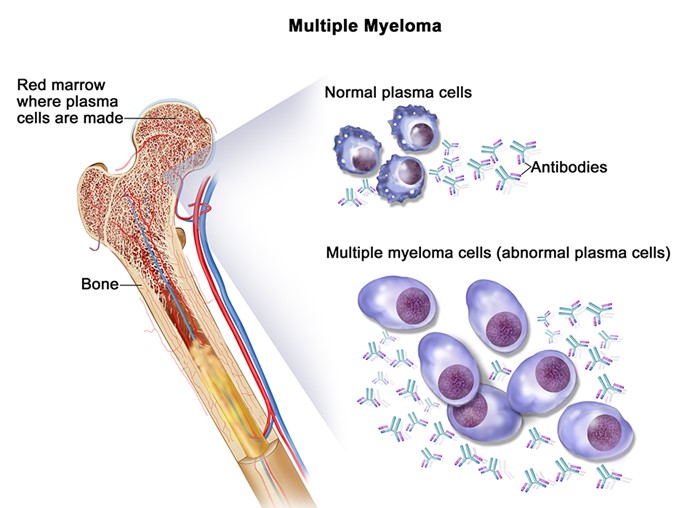A nurse is caring for a client who has multiple myeloma and is receiving thalidomide, an angiogenesis inhibitor, as part of targeted therapy. The nurse should instruct the client to report which of the following adverse effects of this drug? (Select all that apply.)
Numbness, tingling, or pain in the extremities
Drowsiness, dizziness, or confusion
Constipation, nausea, or vomiting
Swelling, redness, or warmth in the legs
Rash, itching, or hives
Correct Answer : A,B,C,E
Choice A reason:
Numbness, tingling, or pain in the extremities are signs of peripheral neuropathy, which is a common and serious side effect of thalidomide³. This condition can affect the nerves that control sensation and movement in the arms and legs, and can lead to permanent nerve damage if not treated.
Choice B reason:
Drowsiness, dizziness, or confusion are signs of central nervous system depression, which is a common and serious side effect of thalidomide³. This condition can affect the brain's ability to regulate alertness, cognition, and coordination, and can increase the risk of falls, accidents, and injuries.
Choice C reason:
Constipation, nausea, or vomiting are signs of gastrointestinal distress, which is a common and mild side effect of thalidomide. This condition can affect the digestive system's ability to process food and fluids, and can lead to dehydration, malnutrition, and electrolyte imbalance if not managed.
Choice D reason:
Swelling, redness, or warmth in the legs are not directly related to thalidomide use, but may indicate a deep vein thrombosis (DVT), which is a blood clot that forms in a vein deep in the body. Thalidomide can increase the risk of DVT by affecting the blood's ability to clot normally. A DVT can be lifethreatening if it breaks off and travels to the lungs, causing a pulmonary embolism.
Choice E reason:
Rash, itching, or hives are signs of allergic reaction, which is a rare but serious side effect of thalidomide³. This condition can affect the skin's immune response to the drug, and can lead to severe skin reactions such as StevensJohnson syndrome or toxic epidermal necrolysis if not treated.

Nursing Test Bank
Naxlex Comprehensive Predictor Exams
Related Questions
Correct Answer is ["A","B","C"]
Explanation
Choice A reason:
Pallor and weakness are signs of anemia, as they indicate a low level of hemoglobin or red blood cells that carry oxygen to the tissues. Pallor is the loss of color in the skin, especially in the face, nails, and inside of the eyelids. Weakness is the feeling of having less energy or strength than usual.
Choice B reason:
Dizziness and headache are signs of anemia, as they indicate a low level of oxygen in the brain. Dizziness is the feeling of being lightheaded or unsteady. Headache is the pain or discomfort in the head, scalp, or neck.
Choice C reason:
Shortness of breath and tachycardia are signs of anemia, as they indicate a low level of oxygen in the lungs and heart. Shortness of breath is the feeling of not being able to breathe enough or catch your breath. Tachycardia is the abnormally fast or irregular heartbeat.
Choice D reason:
Constipation and abdominal pain are not directly related to anemia or fatigue, but may indicate other conditions such as dehydration, bowel obstruction, or infection. Constipation is the difficulty or infrequency in passing stools. Abdominal pain is the pain or discomfort in the stomach or belly area.
Choice E reason:
Difficulty sleeping and concentrating are not directly related to anemia or fatigue, but may indicate other conditions such as stress, depression, or anxiety. Difficulty sleeping is the trouble falling asleep or staying asleep. Difficulty concentrating is the trouble focusing on tasks or remembering things.
Correct Answer is D
Explanation
Choice A reason:
Epoetin alfa (Epogen) is a drug that stimulates the production of red blood cells in the bone marrow, not platelets⁴. It is used to treat anemia caused by chemotherapy, chronic kidney disease, or other conditions.
Choice B reason:
Filgrastim (Neupogen) is a drug that stimulates the production of white blood cells in the bone marrow, not platelets⁴. It is used to prevent or treat neutropenia caused by chemotherapy, bone marrow transplant, or other conditions.
Choice C reason:
Sargramostim (Leukine) is a drug that stimulates the production of white blood cells and red blood cells in the bone marrow, not platelets⁴. It is used to prevent or treat neutropenia caused by chemotherapy, bone marrow transplant, or other conditions.
Choice D reason:
Oprelvekin (Neumega) is a drug that stimulates the production of platelets in the bone marrow⁴. It is used to prevent or treat thrombocytopenia caused by chemotherapy. It works by mimicking the action of thrombopoietin, a hormone that regulates platelet development.

Whether you are a student looking to ace your exams or a practicing nurse seeking to enhance your expertise , our nursing education contents will empower you with the confidence and competence to make a difference in the lives of patients and become a respected leader in the healthcare field.
Visit Naxlex, invest in your future and unlock endless possibilities with our unparalleled nursing education contents today
Report Wrong Answer on the Current Question
Do you disagree with the answer? If yes, what is your expected answer? Explain.
Kindly be descriptive with the issue you are facing.
